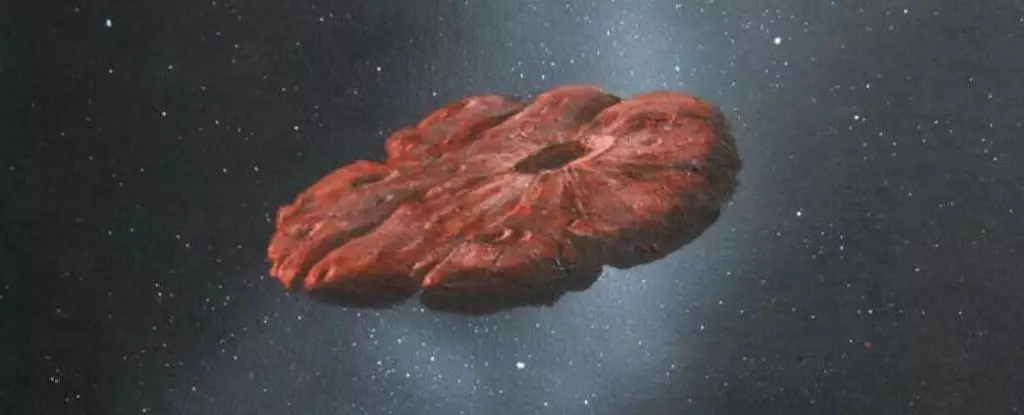The cosmos continues to unearth its secrets at an astonishing pace, and one such secret arrived in late 2017 when a fast-moving interstellar object zipped through our Solar System. Dubbed ‘Oumuamua, which translates to “scout” in Hawaiian, this peculiar elongated visitor captivated astronomers worldwide. Measuring approximately 400 meters in length and displaying a shape reminiscent of a cosmic cigar, ‘Oumuamua marked a historic moment as the first known interstellar object (ISO) to be identified in our celestial neighborhood.
As celestial wanderers, ISOs enter our Solar System as cosmic drifters, remnants of planetary systems torn apart by violent cataclysms. Their paths can be traced back to distant stars, with ‘Oumuamua potentially wandering through the Milky Way for millions of years before its brief encounter with our planet. In 2019, another ISO, the Borisov Comet, further fueled interest in the field, highlighting the tantalizing potential these celestial visitors hold for scientific discovery.
The Challenge of Detection
Despite the revelation that there may be over 10 septillion ISOs traversing the Milky Way, their fleeting presence poses a significant challenge for astronomers. The sheer speed at which these objects travel means they spend little time within our observational range. In fact, large ISOs like ‘Oumuamua rarely pass through our skies, making their detection an extraordinary stroke of luck. Ground-based telescopes and space observatories often fail to catch sight of these cosmic intruders until they have already whizzed past, leaving scientists scrambling to analyze data in their wake.
This predicament raises an important question: Given the abundance of ISOs, why have we observed so few? The answer lies primarily in the unpredictability of these celestial bodies. The arrival of an ISO can be a stroke of chance, making effective preparation for interception a colossal challenge.
Innovative Strategies for Interception
While the discovery of ISOs has opened new frontiers for applicable scientific inquiry, the real potential comes from studying them closely. However, getting up close and personal with these celestial wanderers is no easy feat. Currently, space exploration strategies hinge on innovative techniques to intercept these fast-moving objects. Innovative missions like NASA’s Bridge and the European Space Agency’s Comet Interceptor are at the forefront of this interstellar hunt.
Bridge envisions a mission that would be launched shortly after an ISO is detected. However, current launch protocols complicate this goal, as we face a restrictive 30-day launch window, which could mean losing valuable opportunities. Meanwhile, Comet Interceptor, set for a 2029 launch, aims to position itself a million miles from Earth to await incoming comets and ISOs alike. This proactive approach seeks to exploit the relatively slower speed of long-period comets, but requires agility and foresight to seize fleeting opportunities when they arise.
Leveraging AI and Advanced Technologies
To enhance our prospects for success, space missions of the future will have to leverage cutting-edge technologies, especially artificial intelligence (AI). The ability of AI to process vast sets of data and react in real-time heralds a new dawn for astronomical observation and interception. The emergence of coordinated “swarms” of small spacecraft equipped with advanced imaging capabilities may allow for multifaceted views of ISOs, ensuring precise observations and analyses mid-flight.
Moreover, projects like the Vera C Rubin Observatory promise a paradigm shift in our ability to detect ISOs with its comprehensive ten-year sky survey. With predictions suggesting a burgeoning detection landscape, the challenge remains: the spacecraft of tomorrow must be equipped to accelerate toward these objects after detection and sustain their energy levels during lengthy periods in “storage orbit.”
Breaking Through with Innovative Propulsion
Traditional propulsion systems may be inadequate for the ambitious tasks of intercepting ISOs. The race is on to develop advanced propulsion technologies that can achieve high speeds without the burden of heavy fuel tanks. One exciting avenue involves the use of solar sails—where sunlight is harnessed to propel lightweight spacecraft through space. Upcoming iterations might even implement laser propulsion to reach unprecedented velocities, making them nimble and cost-effective compared to conventional rocket fuels.
High-speed approaches also bring their own risks, with spacecraft needing to withstand extreme temperatures and potential erosion from dust. Researchers are already investigating lighter, more resilient materials, including carbon fiber and advanced ceramics, that could shield spacecraft while ensuring they maintain optimal velocity.
A Collaborative Future for Cosmic Discovery
Integrating ground-based telescopes and space missions orchestrates a concerted effort to predict, pursue, and observe ISOs effectively. We stand at the precipice of a revolution in our understanding of these cosmic wonders, but significant challenges loom. Potential budget cuts to space science initiatives could stifle momentum in this exciting field, thus hampering our ability to capture the knowledge that ISOs hold about distant star systems.
As our quest for understanding accelerates, harnessing innovative technologies and visionary strategies will be essential. Failure to adapt and evolve may leave humanity watching in helpless awe as yet another cosmic wanderer speeds away into the cosmic abyss. The pursuit of interstellar objects is not just an adventure; it’s an urgent quest to expand our horizons in an unimaginable universe.


Leave a Reply